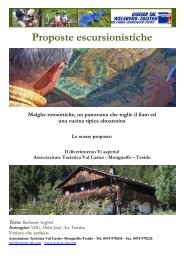info & - Hotel Gschwendt
info & - Hotel Gschwendt
info & - Hotel Gschwendt
You also want an ePaper? Increase the reach of your titles
YUMPU automatically turns print PDFs into web optimized ePapers that Google loves.
Einblick in die Geschichte<br />
„das Pustertal“<br />
Bereits im 11. Jh. war der Name Pustrissima<br />
mehrfach urkundlich erwähnt. Aufgrund der<br />
vorübergehenden slawischen Besiedlung im<br />
östlichen Pustertal versuchte man, den Namen<br />
von dieser Seite zu erklären. Man war der Meinung,<br />
der Name sei von pustu (öde) abgeleitet worden.<br />
Aber weitaus treffender dürfte die Erklärung des<br />
bekannten Fachmannes K. Finsterwalder sein,<br />
der den Namen auf einen keltischen Personennamen,<br />
auf Busturissa (Gau eines Busturus)<br />
zurückführt, der vielleicht ein Stammesfürst der<br />
Saevaten gewesen sein könnte.<br />
Die Dolomiten<br />
Dem französischen Forscher Deodat de Dolomieu<br />
verdanken die „bleichen Berge“ der Region ihren<br />
Namen. Er untersuchte gegen Ende des 18. Jh.<br />
das Gestein auf Kalk und kohlensaure Magnesia.<br />
Dessen zu Ehren erhielten die Berge dann den<br />
Namen Dolomiten. Seit dem 26. Juni 2009<br />
gehören sie zum renommierten UNESCO-Weltnaturerbe.<br />
Breve excursus etimologico<br />
sulla “Val Pusteria”<br />
Il nome Pustrissima era già ampiamente documentato<br />
agli inizi dell’XI secolo. Vista la temporanea<br />
occupazione slava nella zona orientale<br />
della valle, si propendeva a giustificare quel<br />
nome, che si riteneva derivato da pustu (vuoto,<br />
inospitale), con la descrizione della triste realtà<br />
della zona. Ma molto più azzeccata sembrerebbe<br />
la spiegazione fornita invece dal noto esperto<br />
K. Finsterwalder che rimanda il toponimo al<br />
termine Busturissa (distretto di un Busturus,<br />
probabilmente un principe della stirpe celtica<br />
dei Sevati).<br />
Le Dolomiti<br />
I “Monti pallidi” devono il nome al noto studioso<br />
e ricercatore francese Deodat de Dolomieu<br />
che sul finire del XVIII secolo si interessò alla<br />
struttura delle rocce calcaree e della magnesia<br />
carbonatica. In suo onore, dunque, queste montagne<br />
presero il nome di Dolomiti. Il 26 giugno<br />
2009 la catena delle Dolomiti è stata proclamata<br />
dall’UNESCO Patrimonio Naturale dell’Umanità.<br />
www.kronplatz.com<br />
The History of the<br />
Pustertal Valley<br />
The name “Pustrissima” can be traced as far<br />
back as the 11th Century, where it is first mentioned<br />
in several historical documents. Due to<br />
the temporary settlement by Slavic peoples in<br />
the eastern Pustertal Valley, there have been<br />
attempts to explain the origin of this name.<br />
It was believed to have been derived from the<br />
word “pustu” (“empty, desolate”). But the explanation<br />
of the well-known expert K. Finsterwalder<br />
is more plausible. He traced the name back to the<br />
Celtic personal name “Busturissa” (“area under<br />
the rule of Busturus”), who may have been a<br />
tribal leader of a people known as the Saevates.<br />
The Dolomites<br />
The name of the “Pale Mountains” of this region<br />
is attributable to the French researcher Deodat<br />
de Dolomieu. In the late 18th Century, he studied<br />
the composition of the mountains and found<br />
that they were made of limestone and magnesium<br />
carbonate. The mountains were then named<br />
“The Dolomites” in honor of him. They were<br />
declared a UNESCO World Nature Heritage Site<br />
in June 26, 2009.<br />
5





